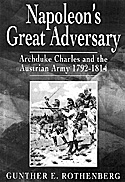 Pages: 277
Pages: 277
Illustrations: 23 black and white reproductions of period illustrations of
uniforms, generals, and battles
Maps: 17--nine strategic showing theater of operations, two grand tactical showing
army maneuvers, and six tactical battle maps showing units down to regiments and battalions
Footnotes: 574 listings in 12 pages
Appendices: None, but there are fourteen tables, charts and diagrams throughout
the text showing unit deployment methods, weapons, and orders of battle
Bibliography: 5 pages listing more than seven manuscript sources, six printed
regulations and instructions, eighteen contemporary memoirs and letters, 72 secondary sources, and seven reference books, many annotated, including asterisks by those which contain substantial source material
Index: 17 pages with 635 listings divided into four separate indexes--persons,
battles & treaties, army units & tactics, states & provinces
Publisher: Sarpedon, New York
Publication Date: 1995 (reprint of 1982 edition)
Binding: Cloth (hardcover)
Price: $29.95
ISBN: I-885119-21-6
Summary: This is the standard reference work on the Austrian army in English. It is
the most thorough survey available of the Austrian army, covering all elements of
Napoleon's primary enemy--internal administrative and political aspects, important leaders and their effectiveness, the evolution of weapons and tactics, and the actual impact all these factors had on the battlefield.
Rothenburg's treatise presents the Austrian army as the largest force continually engaged against the French Revolution and Napoleon, and contends that it carried most of the burden of the war on the continent. This book is a balanced story of that army and its leaders, based mainly on Austrian reference sources.
Between 1792 when the French Revolutionary government of Girondin declared war on the "King of Hungary and Bohemia" (Austria), and Napoleon's final defeat in 1815, Europe saw constant tension or open hostilities. Except for a fourteen month Peace of Amiens and the eleven months of Napoleon's first exile to Elba, there were 23 years of wars.
Rothenburg states that Great Britain was at war with France for 240 months, sustaining numerous coalitions with its Royal Navy and golden guineas. However, he emphasizes that the land fighting against the French Revolution and First Empire was shouldered primarily by Austria, which was at war for a total of 108 months, compared to 58 for Prussia and 55 for Russia.
The Austrian army inflicted the first true defeat on Napoleon in battle, at Aspern-Essling during the 1809 campaign. Although repeatedly defeated, having its capital of Vienna occupied twice, and losing large regions of territory by unfavorable peace treaties dictated to it, Austria always rose again. In 1813 Austria contributed the largest contingent to the allied effort in Germany.
This is a well-written and meticulously researched book. Anyone seeking a better understanding of the Napoleonic era must also study France's enemies. Rothenberg's treatise on the Austrian army and its best commander, Archduke Charles, is an essential reference work for any serious Napoleonic library.
More Reviews:
-
Historical Description of the Clothing and Arms of the Russian Army
Memoirs of a Polish Lancer: The Pamietnicki of Derydery Chlapowski
Napoleon's Great Adversary: Archduke Charles and the Austrian Army 1792-1814
Back to Empire, Eagles, & Lions Table of Contents Vol. 2 No. 14
Back to EEL List of Issues
Back to MagWeb Master Magazine List
© Copyright 1995 by Emperor's Headquarters
This article appears in MagWeb (Magazine Web) on the Internet World Wide Web.
Other military history articles and gaming articles are available at http://www.magweb.com
